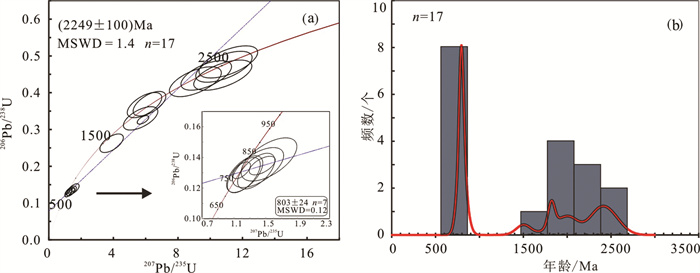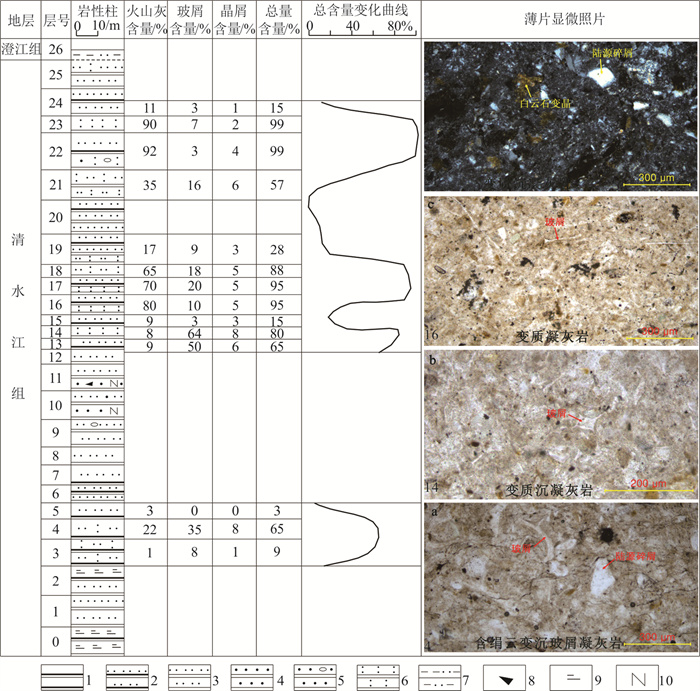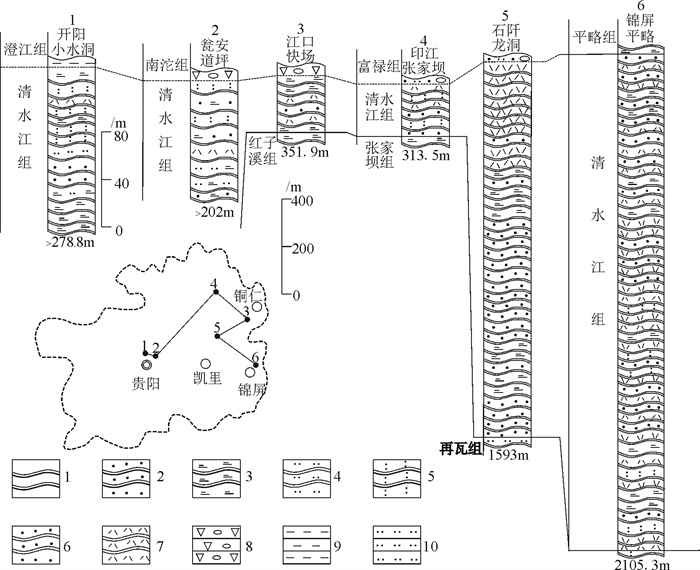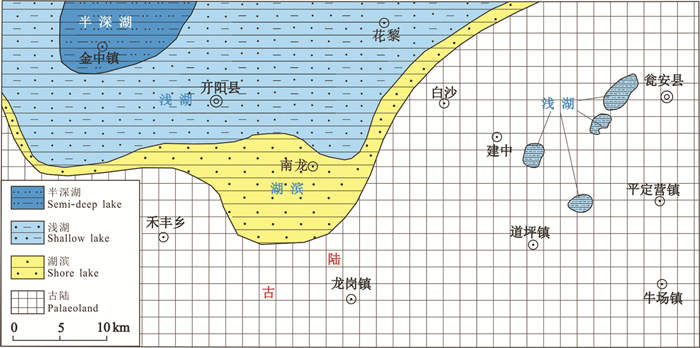Sedimentary age determination and palaeogeographic pattern of Neoproterozoic Qingshuijiang Formation in Central Guizhou Province
-
摘要:研究目的
黔中开阳地区清水江组是新元古代在扬子地块边缘形成的一套浅变质陆源碎屑岩夹火山碎屑岩组合,本文通过对陆源碎屑岩沉积特征和火山碎屑岩年代学的研究,旨在准确厘定其沉积时限、物源及其古地理格局。
研究方法本次在详实的野外地质调查基础上,采用LA-ICP-MS分析方法对其顶部沉凝灰岩碎屑锆石进行U-Pb年龄测定,并进行区域地层对比。
研究结果测得锆石U-Pb年龄主要分为两组,即古元古代2488~1821 Ma和新元古代838~779 Ma,最小年龄组的加权平均值为(802±24)Ma,火山碎屑含量的统计结果显示该时期的岩浆活动存在明显的幕式分布特征和周期性;区域地层对比结果显示黔中开阳地区出露的清水江组与铜仁江口、印江地区所出露的相似,可能相当于黔东南地区清水江组的底部。
结论黔中地区清水江组最晚的沉积时限为800 Ma左右,物源主要来自扬子陆块西缘的川滇黔地区,其丰富的火山碎屑可能来自新元古代中期超大陆裂解过程中构造-岩浆活动的第二幕至第三幕,并在随后的雪峰运动中发生海陆转换,形成了南高北低、呈北东向延伸的古陆,奠定了新元古代中期南华纪的古地理格局。
创新点:厘定黔中地区清水江组的沉积时限,确定黔中开阳地区新元古代中期南高北低、呈北东向延伸的的古地理格局。
Abstract:This paper is the result of geological survey engineering.
ObjectiveThe Qingshuijiang Formation in Kaiyang area of Central Guizhou is a set of epimetamorphic terrigenous clastic rocks intercalated with pyroclastic rocks, which formed at the margin of the Yangtze block in Neoproterozoic. In order to accurately determining the depositional age, the provenance and the paleogeographic pattern of the Qingshuijiang Formation, the sedimentary characteristics of terrigenous clastic rocks and the chronology of pyroclastic rocks are studied in this paper.
MethodsBased on the detailed geological survey, the detrital zircon U-Pb age of the tuffites at the top of this Formation was determined by LA-ICP-MS analysis, and the regional stratigraphic correlation was carried out.
ResultsZircon U-Pb ages are divided into two groups, 2488-1821 Ma in Paleoproterozoic and 838-779 Ma in Neoproterozoic, respectively, with a weighted average of (802±24) Ma for the youngest age group. The statistical results of pyroclastic content shows that the magma activity in this period has obvious episodic distribution and periodicity. Regional stratigraphic correlation results show that the exposure nature of the Qingshuijiang Formation in Kaiyang area is similar to Tongren and Yinjiang area, and may be equivalent to the bottom of the Qingshuijiang Formation in southeast Guizhou area.
ConclusionsThe latest depositional age limit of the Qingshuijiang Formation in Central Guizhou is about 800 Ma. The provenance mainly comes from Sichuan-Yunnan-Guizhou region on the western margin of the Yangtze Landmass. and the abundant volcanics may come from the second to third episodes of tectonic magmatic activity during the breakup of the supercontinent in the middle Neoproterozoic. The sea-land conversion occurred in the subsequent Xuefeng movement, and formed an ancient land extending in the northeast with a higher distribution of altitude in the south than the north, which established the paleogeographic framework of the Nanhua period in the middle Neoproterozoic.
-
1. 引言
江南造山带是华南前寒武纪连接扬子地块和华夏地块最重要的构造单元,其形成和演化长期以来备受关注(邓奇等,2016;周传明,2016)。而分布于江南造山带的一套前寒武纪浅变质陆源碎屑岩夹火山碎屑岩组合则成为众多专家学者研究江南造山带的重要载体(Li et al.,2002,2006;Zheng et al.,2007;高林志等,2010;汪正江等,2010;戴传固等, 2013, 2015;张启锐,2014;覃永军等,2015)。由于黔东南地区前寒武纪地层出露较全,成为长期以来贵州境内研究前寒武纪地层的重要地区。而处于扬子地块与江南造山带结合部位的黔中地区(图 1a),虽然有前寒武纪地层出露,但由于出露地层少、面积小,故关于前寒武纪地层的研究程度相对较低。
![]() 图 1 贵州省大地构造位置图(a)和开阳地区采样、剖面位置图(b)1—清水江组;2—褶皱轴及编号;3—断层;4—剖面位置;5—采样点;6—地名;①—师宗—松桃—九江断裂带;②—罗城—龙胜—景德镇断裂带;③北海—萍乡—绍兴断裂带;④—红河断裂带;⑤—哀牢山断裂带;⑥—小江断裂带;⑦—金钟背斜;⑧—翁昭背斜;⑨—龙岗向斜;⑩—高坪背斜;Ⅰ—扬子地块;Ⅱ—江南造山带;Ⅲ—华夏地块Figure 1. Tectonic location of Guizhou Province (a) and sampling and section location map in Kaiyang area(b)1-Qingshuijiang Formation; 2-Pleat axis and number; 3-Fault; 4-Section position; 5-Sampling position; 6-Place name; ①-Shizong-Songtao-Jiujiang Fault zone; ②-Luocheng-Longsheng-Jingdezhen Fault zone; ③-Beihai-Pingxiang-Shaoxing Fault zone; ④-Honghe Fault zone; ⑤-Ailaoshan Fault zone; ⑥-Xiaojiang Fault zone; ⑦-Jinzhong anticline; ⑧-Wengzhao anticline; ⑨-Longgang syncline; ⑩-Gaoping anticline; Ⅰ-Yangtze block; Ⅱ-Jiangnan orogen; Ⅲ-Cathaysia block
图 1 贵州省大地构造位置图(a)和开阳地区采样、剖面位置图(b)1—清水江组;2—褶皱轴及编号;3—断层;4—剖面位置;5—采样点;6—地名;①—师宗—松桃—九江断裂带;②—罗城—龙胜—景德镇断裂带;③北海—萍乡—绍兴断裂带;④—红河断裂带;⑤—哀牢山断裂带;⑥—小江断裂带;⑦—金钟背斜;⑧—翁昭背斜;⑨—龙岗向斜;⑩—高坪背斜;Ⅰ—扬子地块;Ⅱ—江南造山带;Ⅲ—华夏地块Figure 1. Tectonic location of Guizhou Province (a) and sampling and section location map in Kaiyang area(b)1-Qingshuijiang Formation; 2-Pleat axis and number; 3-Fault; 4-Section position; 5-Sampling position; 6-Place name; ①-Shizong-Songtao-Jiujiang Fault zone; ②-Luocheng-Longsheng-Jingdezhen Fault zone; ③-Beihai-Pingxiang-Shaoxing Fault zone; ④-Honghe Fault zone; ⑤-Ailaoshan Fault zone; ⑥-Xiaojiang Fault zone; ⑦-Jinzhong anticline; ⑧-Wengzhao anticline; ⑨-Longgang syncline; ⑩-Gaoping anticline; Ⅰ-Yangtze block; Ⅱ-Jiangnan orogen; Ⅲ-Cathaysia block黔中地区新元古代清水江组是分布在扬子地块边缘的一套浅变质陆源碎屑岩夹火山碎屑岩组合,其火山碎屑岩主要为沉凝灰岩、变质沉凝灰岩、变质凝灰岩,其地层划分与时代归属主要依据其相似于黔东南地区清水江组而进行沿用。本文的研究区主要位于黔中开阳—瓮安一带,该地区在雪峰运动后隆升为古陆,遭受剥蚀,同时由于清水江组出露面积小、厚度有限且变化大,上覆地层多样,造成其研究程度较低。但黔东南地区清水江组层型剖面厚度巨大,从而使针对黔中开阳地区出露的清水江组相当于层型剖面的什么位置,二者沉积时限有无差别等的研究显得十分重要。本次工作在详实的野外地质调查基础上,对清水江组沉凝灰岩进行锆石U-Pb测年,为黔中地区的清水江组的沉积时限提供最小年龄制约,以确定黔中地区清水江组的沉积物源和后期的剥蚀情况,并进行区域地层对比和火山碎屑含量统计,为探讨黔中地区在新元古代的盆地演化提供依据。
2. 区域地质背景
研究区位于上扬子陆块西南缘,在早新元古代处于裂陷盆地沉积环境,在雪峰运动的影响下隆升成古陆,遭受剥蚀形成的基底决定了南华纪的古地理格局。研究区褶皱及断裂均较为发育,构造线方向主要呈北东向和近南北向,长条状、脊状褶皱与逆冲断层伴生,组成本区构造的基本格架,其中影响较大的褶皱构造自西向东主要有金钟(洋水)背斜、翁昭背斜、龙岗向斜等(图 1b)。清水江组为研究区出露最老地层,仅见于背斜核部地区,但未见底,横向变化大,与上覆南华系澄江组、南沱组平行不整合接触。
开阳金钟—翁召一带清水江组主要为灰色、灰绿色薄—厚块状浅变质的含凝灰质细—中砂岩、变质细粒岩屑长石砂岩、变质沉凝灰岩、变质凝灰岩,与上覆南华系澄江组紫红色厚层—块状粉砂质泥岩平行不整合接触。瓮安玉华—高坪一带清水江组主要为中—厚层浅变质石英砂岩、长石石英砂岩、岩屑杂砂岩、变质凝灰岩夹少量凝灰质板岩,与上覆南华系南沱组平行不整合接触,极少数地区与上覆澄江组平行不整合接触。本次所测清水江组剖面位于翁昭背斜和高坪背斜核部,未受断层破坏,剖面完整。
3. 样品采集与分析方法
本次工作在开阳金钟镇西约1 km晏家寨采集浅变质沉凝灰岩样品进行锆石U-Pb年龄测试,在翁昭背斜小水洞剖面系统采集样品进行火山碎屑物质分析(图 1b)。所采集样品主要有:粉砂质绢云板岩、绢云变粉砂岩、变质含凝灰质粉砂岩、变质沉凝灰岩、变质凝灰岩等。
样品薄片鉴定由贵州省地质调查院王敏博士完成。锆石的分离、挑选由河北省廊坊市地岩矿物分选有限公司完成,首先通过常规粉碎、重、磁选方法从样品中分离出锆石颗粒,然后在双目镜下进行人工挑纯。将挑选出的待测锆石颗粒置于玻璃板上,用无色透明环氧树脂固定,将靶上的锆石进行粗磨、细磨至约一半使锆石中心部位暴露并抛光。在分析测试之前先对锆石进行反射光、透射光照相及阴极发光(CL)图像采集,仔细观察锆石颗粒形态和内部结构,选定合适的位置进行U-Pb同位素测定。锆石阴极发光(CL)图像采集在北京离子探针中心使用与HITHCH S-3000N型扫描电镜相连接的GEOL Gatan Chroma阴极发光仪完成。锆石U-Pb定年测试在中国科学技术大学(合肥)激光剥蚀电感耦合等离子体质谱实验室(LA-ICP-MS)进行。仪器为四极杆等离子质谱仪(型号:Perkin Elmer Elan DRCII),193 nm波长ArF准分子激光剥蚀系统(型号:GeoLas Pro)用于样品的剥蚀进样。采用高纯He(99.999%)作为剥蚀物质的载气,激发频率为10 Hz,激光束能量为10 J/cm2,激光剥蚀所用束斑直径为24 μm,偶有16 μm(由于部分样品锆石颗粒较小,故采用小直径束斑)。
锆石U-Pb同位素组成分析采用线性漂移校正,因此用91500国际标准锆石作为外标来进行线性漂移校正。详细测试分析过程参见文献(Yuan et al.,2008)。原始数据处理通过Excel制表软件中加载宏程序Ladating@Zrn完成,普通Pb校正使用Anderson(2002)推荐的方法ComPb corr#3-18来完成。运用Ludwig(2003)编制的Isoplot/Ex_ver4.15软件计算加权平均年龄计算、绘制谐和图和频率分布直方图。样品分析过程中,91500标样作为未知样品的分析结果对应的年龄推荐值在误差范围内一致。
4. 分析结果
4.1 锆石U-Pb分析结果
样品锆石CL图像(图 2)显示本次所采清水江组样品(D8800)的锆石晶体颗粒较小,大多在50~100 μm,多呈短柱状或近椭圆形,部分有磨圆,少量较破碎,发育有典型的岩浆生长振荡环带和韵律结构,属于岩浆结晶的产物。目前普遍认为岩浆成因的锆石Th、U含量较高,且Th/U比值较大,一般大于0.4,而变质锆石的Th/U比值一般小于0.1(吴元保和郑永飞,2004;吕留彦等,2019)。本次选取29颗具有代表性的锆石进行U-Pb同位素分析,获得17组谐和度大于90%的有效年龄,有效数据的锆石U、Th含量较高,U含量为44.71×10-6~324.67×10-6,Th含量为10.1×10-6~296.13×10-6,Th/U值在0.13~1.39,仅有两颗锆石Th/U值小于0.4,具典型的岩浆锆石特征(表 1)。单颗锆石U-Pb测年数据介于2545~779 Ma,大致可分为2组(图 3)。
表 1 清水江组沉凝灰岩样品锆石U−Pb定年测试结果Table 1. Zircon U−Pb dating results of tuff samples in the Qingshuijiang Formation
第一组为新元古代838~779 Ma,共7颗(图 2),占总有效数据的41.2%,Th/U值为0.52~1.39,振荡环带均匀清晰,晶型较为完整,棱角分明,为岩浆成因锆石,加权平均年龄为(802±24)Ma。第二组为古元古代的2488~1821 Ma,共8颗,占总有效数据的47.1%,Th/U值为0.13~1.28,其中第9和16号两颗锆石Th/U值小于0.4,第20号、22号两颗锆石晶核外围有增生边,可能为变质增生锆石,其他锆石振荡环带均匀清晰,晶型较为完整,为岩浆成因锆石。另外2颗锆石年龄分别为12号1505 Ma和18号2545 Ma,其中12号锆石有一定的磨圆,晶核内部较均匀,具有振荡环带,晶核外围有增生边,Th/U值为0.3,为变质增生锆石;18号锆石Th/U值为0.73,振荡环带明显,为岩浆成因锆石。
4.2 清水江组火山碎屑分析
研究区内清水江组岩石类型繁多,主要为不同成分、粒径的陆源碎屑与火山碎屑以不同比例相互掺杂而形成的岩石。陆源碎屑的成分以长石居多,石英次之;火山碎屑以火山灰为主,玻屑次之,少见晶屑。岩石中陆源碎屑、火山碎屑均具轻微变质重结晶现象,黏土矿物均为显微鳞片状变晶结构。据开阳小水洞剖面样品统计,除变质凝灰岩和变质沉凝灰岩外,部分变质粉砂岩、板岩中亦含有火山碎屑,一般在20%左右。
变质凝灰质粉砂岩:变余层纹—条纹—条带状构造,陆源碎屑和火山碎屑不均匀分布,偏集呈层纹—条纹—条带状产出,变余粉砂状结构。陆源碎屑约70%,粒度一般 < 0.06~0.004 mm,主要为粉砂级陆源碎屑,呈次棱角状、次圆状、圆状,磨圆度中等,分选性较好,成分主要为斜长石矿物屑38%、石英矿物屑25%、岩屑5%及其他矿物屑(白云母矿物屑、锆石矿物屑等)2%。火山碎屑约28%,一般 < 0.05 mm,为凝灰级火山碎屑,成分以火山灰为主,玻屑和晶屑少见,已基本上分解形成微粒石英。二者均具轻微变质重结晶现象。微量矿物组分主要有石英、黄铁矿、铁质,呈基底微量矿物构成形式产出,含量均 < 1%。
变质沉凝灰岩:层状构造,变余凝灰结构,主要由火山碎屑、陆源碎屑和绢云母变晶3种组分构成。火山碎屑约65%,粒度一般 < 0.05 mm,为凝灰级火山碎屑,成分以玻屑为主,火山灰和晶屑(长石晶屑、石英晶屑等)次之,现已基本上分解形成微粒石英;陆源碎屑约30%,分布较为均匀,粒度一般 < 0.06~0.004 mm,基本上为粉砂级陆源碎屑,呈次棱角状、次圆状、圆状,磨圆度中等,而分选性较好,碎屑成分为长石矿物屑(20%)、石英矿物屑(7%)及其他矿物屑(黑云母矿物屑、白云母矿物屑、绿泥石矿物屑、锆石矿物屑等)3%,矿物成熟度中等;二者均具轻微变质重结晶现象。绢云母变晶约3%,零散分布,结晶粒度 < 0.10 mm,显微鳞片状变晶。微量矿物组主要有石英、黄铁矿、铁质,呈基底微量矿物构成形式产出,含量均 < 1%(图 4b、d)。
![]() 图 4 开阳地区清水江组火山碎屑含量变化曲线图及显微镜下照片1—板岩;2—粉砂质板岩;3—变质粉砂岩;4—变质砂岩;5—变质含砾砂岩;6—变质凝灰岩;7—粉砂质泥岩;8—岩屑;9—绢云母;10—长石Figure 4. Curve of volcanic debris content and photomicrographs of the Qingshuijiang Formation in Kaiyang area1-Slate; 2-Silty slate; 3-Metamorphic siltstone; 4-Metamorphic sandstone; 5-Metamorphic gravelly sandstone; 6-Metamorphic tuff; 7-Silty mudstone; 8-Debris; 9-Sericite; 10-Feldspar
图 4 开阳地区清水江组火山碎屑含量变化曲线图及显微镜下照片1—板岩;2—粉砂质板岩;3—变质粉砂岩;4—变质砂岩;5—变质含砾砂岩;6—变质凝灰岩;7—粉砂质泥岩;8—岩屑;9—绢云母;10—长石Figure 4. Curve of volcanic debris content and photomicrographs of the Qingshuijiang Formation in Kaiyang area1-Slate; 2-Silty slate; 3-Metamorphic siltstone; 4-Metamorphic sandstone; 5-Metamorphic gravelly sandstone; 6-Metamorphic tuff; 7-Silty mudstone; 8-Debris; 9-Sericite; 10-Feldspar变质凝灰岩:层状构造,变余凝灰结构。火山碎屑约95%,粒度一般 < 0.05 mm,为凝灰级火山碎屑,成分以火山灰为主,玻屑和晶屑次之,现已基本上分解形成微粒石英;陆源碎屑约3%,基本上为粉砂级陆源碎屑,呈次棱角状、次圆状、圆状,磨圆度中等,分选性较好,碎屑成分为石英矿物屑(2%)及其他矿物屑(黑云母矿物屑、白云母矿物屑、绿泥石矿物屑、锆石矿物屑等,1%),二者分布较为均匀,具轻微变质重结晶现象。微量矿物组主要有石英、黄铁矿、铁质,呈基底微量矿物构成形式产出,含量均 < 1%(图 4c)。
火山碎屑含量变化图显示黔中开阳地区在清水江组沉积期内至少存在4次较强的岩浆活动周期,火山碎屑最高含量为65%、80%、95%、99%(图 4),表明岩浆活动总体上具有逐渐增强的趋势。每个岩浆活动周期内其活动强度具有由低到高再到低的韵律变化,说明该时期的岩浆活动存在强弱交替的特征,其中第2与第3次强岩浆活动较为连续,其间歇期内岩浆活动并未完全停止。
5. 讨论
5.1 清水江组沉积时代界定
清水江组中大量火山碎屑物质为该时期的地层划分对比提供了显著标志,区域上清水江组与贵阳—芷江一线以北鹅家坳组,从江—黎平一线以南拱洞组为同期异相沉积。在本次研究区内尹崇玉等(2007)在瓮安北斗山清水江组顶部采集层凝灰岩获得SHRIMP锆石年龄为(803±12)Ma,在开阳金钟马路坪组(现更名为澄江组,平行不整合于清水江组之上)底部采集含锆石似黏土岩获得SHRIMP锆石年龄为(795±15)Ma。本次获得的清水江组沉凝灰岩锆石年龄较为集中,下交点加权平均年龄为(802±24)Ma,在误差范围内与上述两个锆石年龄一致,且锆石晶型完整,棱角分明,振荡环带明显,为近源同喷发沉积,表明黔中开阳—瓮安地区的清水江组出露层位大致相同,沉积年龄为新元古代。
前人针对清水江组或同期地层的年代测定数据较多,贵州境内主要集中于黔东南地区(表 2),所测年龄主要集中于750~775 Ma,黔中及黔东北地区所报道清水江组或同期地层的年龄主要集中于780~800 Ma。针对清水江组上、下地层的年龄前人亦有报道,贵州台江清水江组下伏地层番召组凝灰质粉砂岩SIMS锆石U-Pb年龄为(802±2)Ma(Wang et al.,2011)。陈建书等(2016)测得贵州雷山清水江组上覆地层平略组凝灰质粉砂岩LA-ICP-MS锆石U-Pb年龄为(758±5.7)Ma,认为华南湘黔桂相邻区新元古代下江群清水江组及相当地层年龄为790~760 Ma。覃永军等(2015)通过对黔东南下江群系统采样定年后认为清水江组底部和中部的沉积时限约为770 Ma和758 Ma,并推测其顶部的沉积时限约为745 Ma。综合前人关于黔东南地区清水江组及其上下地层的年龄分析,将清水江组沉积时限大致约束在790~745 Ma。综上所述黔中地区所出露的清水江组的沉积时限可能相当于黔东南地区的底部。
表 2 贵州清水江组锆石年龄Table 2. Zircon age of the Qingshuijiang Formation in Guizhou
5.2 区域地层对比及古地理格局
研究区内清水江组主要出露于背斜核部,出露厚度约180~220 m,结合区域剖面资料及该组地层分布特点,本文仅从区内出露的清水江组与区域上进行对比分析(图 5)。
![]() 图 5 清水江组典型剖面柱状对比图1—板岩;2—砂质板岩;3—绢云母板岩;4—变质粉砂岩;5—凝灰质板岩;6—变质砂岩;7—变质沉凝灰岩;8—冰碛砾岩;9—粉砂岩;10—泥岩Figure 5. Columnar comparison chart of typical section in the Qingshuijiang Formation1-Slate; 2-Sandy slate; 3-Sericite slate; 4-Metamorphic siltstone; 5-Tuffaceous slate; 6-Metamorphic sandstone; 7-Metamorphic sedimentary tuff; 8-Moraine conglomerate; 9-Siltstone; 10-Mudstone
图 5 清水江组典型剖面柱状对比图1—板岩;2—砂质板岩;3—绢云母板岩;4—变质粉砂岩;5—凝灰质板岩;6—变质砂岩;7—变质沉凝灰岩;8—冰碛砾岩;9—粉砂岩;10—泥岩Figure 5. Columnar comparison chart of typical section in the Qingshuijiang Formation1-Slate; 2-Sandy slate; 3-Sericite slate; 4-Metamorphic siltstone; 5-Tuffaceous slate; 6-Metamorphic sandstone; 7-Metamorphic sedimentary tuff; 8-Moraine conglomerate; 9-Siltstone; 10-Mudstone开阳小水洞剖面变质凝灰岩、变质凝灰质板岩及变质沉凝灰岩主要集中于残余地层的中上部,与上覆澄江组平行不整合接触;福泉道坪剖面变质凝灰岩、变质凝灰质板岩主要集中于残余地层的顶部,与上覆南沱组平行不整合接触。研究区内清水江组残留地层中陆源碎屑颗粒成分及粒度差异明显,西部开阳一带较东部瓮安—福泉一带石英颗粒含量多,陆源碎屑粒度细、成熟度高,但砾石含量较少。
铜仁江口、印江、石阡所出露的清水江组同为剥蚀残留,与上覆南沱组、富禄组平行不整合接触,主要为凝灰质板岩、变质凝灰岩、变质砂岩、绢云母板岩,而江口、印江两地清水江组残留厚度较小;黔东南锦屏清水江组层型剖面发育完整,以凝灰质板岩为主,夹变质凝灰岩、变质沉凝灰岩、变质砂岩和变质粉砂岩(贵州省地质调查院,2017;张予洁等,2020)。对比区域资料,黔中开阳—瓮安一带出露的清水江组大致与铜仁江口、印江两地的相似,同处于古陆隆升区剥蚀作用较强,而铜仁石阡地区残留厚度较大,表明其遭受剥蚀较少,而黔东南锦屏地区清水江组为完整地层,表明受新元古代中期雪峰运动的影响扬子陆块的隆升幅度较大,隆升形成的古陆大致呈北东-南西向。
在南华纪间冰期随着海平面上升,低洼地区沉积了湖泊相的澄江组(图 6),随着南华纪南沱冰期的到来,区内海平面下降,在研究区内东部玉华—英坪一带局部低洼处沉积了南沱组。黔中开阳地区南华纪地层现存较少,主要为南华系澄江组及少量南沱组覆于清水江组之上,呈平行不整合接触。澄江组主要分布于开阳白马洞—禾丰—白沙以北地区,其中西部金钟、中部翁昭一带,保留厚度多在100 m以上,东部地区见零星出露但厚度极薄,总体上呈现由西至东,由北向南逐渐减薄甚至缺失;南沱组冰积砾岩厚度极小,零星分布于研究区东部,平行不整合于澄江组或清水江组之上。经过南华纪的充填、夷平,研究区的古地貌格局已差异不大,主要表现为全区均有稳定厚度的陡山沱组或相当层位分布,其局部岩性变化也反映了区内古地貌的复杂性。以陡山沱组为等时面,结合南华系的沉积厚度及岩石类型可推测黔中开阳地区南华纪澄江组的沉积基底整体上为南高北西低,即开阳白马洞—禾丰—白沙以北地区为起伏不平、谷口向北的谷地,东部地区则呈现出高低不平的山地、丘陵地貌(邓克勇等,2015)。结合区域残留清水江组的厚度,表明黔中开阳—瓮安地区受雪峰运动的影响发生了较大范围的沉积-构造转换,沉积盆地受挤压隆升,形成了南高北低、北东向延伸的古陆,并遭受长时间的剥蚀,形成了复杂的古地貌,奠定了南华系的沉积基底(沈洪娟等,2020)。
5.3 碎屑锆石物源与火山活动分析
本次清水江组样品分析的碎屑锆石较为丰富,大多晶形完整,晶棱平直,棱角分明,近源特征非常明显,少部分存在明显的搬运磨圆痕迹。测试分析获得一个新太古代的锆石年龄为2545 Ma(图 2e)。近年来的研究表明在扬子陆块分布有非常广泛的太古宙基底,Zheng et al.(2006)在湖北京山、湖南宁乡、贵州镇远的3个煌斑岩筒中发现了大量太古宙火山岩中的捕获锆石,年龄主要分布在2.9~2.8 Ga和2.6~2.5 Ga(郑永飞和张少兵,2007);陈岳龙等(2004)在四川冕宁沙坝的花岗质片麻岩中获得(2468±11)Ma的锆石继承核,这些锆石可能与新太古代超大陆裂解过程中的岩浆活动有关。本次所获得新太古代年龄的锆石振荡环带清晰,为岩浆成因,不完整且有一定的磨圆,推测其物源可能为扬子陆块西缘的川黔地区。
古元古代2488~1821 Ma的锆石有8颗,扬子陆块古元古代的年龄信息也广泛存在。Qiu et al.(2000)在北部崆岭地区的奥长花岗片麻岩和变泥质岩中分别得到了1.99 Ga和1.93 Ga的SHRIMP谐和年龄;Zheng et al.(2006)在湖北京山、湖南宁乡、贵州镇远的3个煌斑岩筒分别获得的LA-ICPMS谐和年龄为2033~1995 Ma、2364~2005 Ma、(1786±12)Ma;陈岳龙等(2004)在四川冕宁沙坝和云南昆明梅树村组(Compston et al.,1992)获得锆石年龄分别为(1990±22)Ma、2069~1842 Ma。除此之外,还有很多关于扬子陆块古元古代锆石年龄的研究,这些锆石大多与Columbia超大陆聚合所引起的构造热事件有关。扬子陆块北缘的崆岭、京山地区,东南缘湖南宁乡,距离本研究区的沉积盆地太远,而位于扬子陆块西缘的四川冕宁沙坝和云南昆明梅树村相距较近,可能为潜在的物源区,同属扬子陆块南西缘的贵州镇远地区不仅发现新太古代的锆石而且有古元古代的锆石,表明该地较为完整地记录了扬子陆块前寒武纪的活动信息,是本区最有可能的物源提供地。
新元古代838~779 Ma的锆石有7颗。前人的研究成果显示,华南新元古代的火山活动具有3个显著的特点:双峰式、多幕式(或阶段性)和广泛性(李献华等,2001;Wang and Li, 2003;Ernst et al.,2008),将分布在全球不同地区的元古代火山岩浆岩群称为相应的大火成岩省(Large Igncous Provinces, LIPs),并认为825 Ma, 800 Ma,780 Ma和755 Ma(可能还包括720 Ma)岩浆事件与Rodinia超大陆裂解相关。新元古代中期火山岩浆活动的阶段性体现在约850~740 Ma(尹崇玉和高林志,2013;张启锐,2014),多幕次特征的岩浆活动(~825,~780和~750Ma)是扬子陆块对新元古代地幔柱活动的响应(Li et al.,2006),强烈的火山岩浆活动不仅是新元古代大陆地壳生长与再造的主要过程(Zheng et al., ,2007;Stern,2008),也可能是新元古代中后期全球冰期形成与生物多样性事件的重要原因(汪正江等,2010)。Rodinia超大陆的裂解在华南地区主要表现为:在Grenville运动背景下,由扬子陆块与华夏陆块汇聚形成的华南陆块在825 Ma开始张裂,形成一系列小型半地堑盆地,在800 Ma裂谷盆地达到高峰形成大型半地堑盆地(魏亚楠等,2015),进入快速沉积阶段。黔中开阳地区清水江组的岩性特征及火山碎屑锆石CL图显示838~779 Ma年龄组的锆石为近源同沉积的火山碎屑,由此可见研究区清水江组的沉积物源可能来自扬子陆块西缘的川黔滇地区。
区域上清水江组含丰富的火山碎屑表明在新元古代扬子陆块周边岩浆活动频繁,并且存在多个活动周期,结合区域新元古代同沉积火山岩的年龄,表明扬子陆块在新元古代裂谷盆地的演化中形成了多个幕次的火山岩浆事件(~825 Ma,~800 Ma,~780 Ma,~750 Ma和~720 Ma)。黔中地区清水江组的火山碎屑可能来源于裂解过程中火山岩浆活动的第二幕至第三幕,代表了华南新元古代裂谷盆地扩张的火山岩浆事件。而黔东南地区清水江组的火山碎屑可能来源于稍晚的第三幕至第四幕火山岩浆事件,代表了华南新元古代裂谷盆地最终形成的火山岩浆事件。
6. 结论
(1)黔中开阳地区清水江组顶部沉凝灰岩锆石U-Pb年龄主要分为两组,即古元古代2488~ 1821 Ma和新元古代838~779 Ma,最小年龄组的加权平均值为(802±24)Ma,将黔中地区清水江组最早沉积时限约束在800 Ma左右,其物源主要来自扬子陆块西缘的川滇黔地区。
(2)区域地层对比显示黔中开阳地区出露的清水江组与铜仁江口、印江两地出露的相似,相当于黔东南地区清水江组的底部。结合上覆地层的古地理特征分析,表明扬子陆块西南缘在新元古代中期受雪峰运动的影响,发生了较大范围的洋-陆转换,形成了南高北低、北东向延伸的古陆,长时间剥蚀造就的复杂地貌奠定了南华纪的古地理格局。
(3)扬子陆块在新元古代裂谷盆地的演化中解形成了多个幕次的火山岩浆事件(~825 Ma,~800 Ma,~780 Ma,~750 Ma和~720 Ma),黔中开阳地区清水江组的火山碎屑可能来源于裂解过程中火山岩浆活动的第二幕至第三幕。
致谢: 野外工作期间得到了项目组成员的大力帮助,岩石薄片鉴定得到了贵州省地质调查院王敏博士的支持,两位审稿专家提出了细致的评审意见,在此一并表示衷心的感谢! -
图 1 贵州省大地构造位置图(a)和开阳地区采样、剖面位置图(b)
1—清水江组;2—褶皱轴及编号;3—断层;4—剖面位置;5—采样点;6—地名;①—师宗—松桃—九江断裂带;②—罗城—龙胜—景德镇断裂带;③北海—萍乡—绍兴断裂带;④—红河断裂带;⑤—哀牢山断裂带;⑥—小江断裂带;⑦—金钟背斜;⑧—翁昭背斜;⑨—龙岗向斜;⑩—高坪背斜;Ⅰ—扬子地块;Ⅱ—江南造山带;Ⅲ—华夏地块
Figure 1. Tectonic location of Guizhou Province (a) and sampling and section location map in Kaiyang area(b)
1-Qingshuijiang Formation; 2-Pleat axis and number; 3-Fault; 4-Section position; 5-Sampling position; 6-Place name; ①-Shizong-Songtao-Jiujiang Fault zone; ②-Luocheng-Longsheng-Jingdezhen Fault zone; ③-Beihai-Pingxiang-Shaoxing Fault zone; ④-Honghe Fault zone; ⑤-Ailaoshan Fault zone; ⑥-Xiaojiang Fault zone; ⑦-Jinzhong anticline; ⑧-Wengzhao anticline; ⑨-Longgang syncline; ⑩-Gaoping anticline; Ⅰ-Yangtze block; Ⅱ-Jiangnan orogen; Ⅲ-Cathaysia block
图 4 开阳地区清水江组火山碎屑含量变化曲线图及显微镜下照片
1—板岩;2—粉砂质板岩;3—变质粉砂岩;4—变质砂岩;5—变质含砾砂岩;6—变质凝灰岩;7—粉砂质泥岩;8—岩屑;9—绢云母;10—长石
Figure 4. Curve of volcanic debris content and photomicrographs of the Qingshuijiang Formation in Kaiyang area
1-Slate; 2-Silty slate; 3-Metamorphic siltstone; 4-Metamorphic sandstone; 5-Metamorphic gravelly sandstone; 6-Metamorphic tuff; 7-Silty mudstone; 8-Debris; 9-Sericite; 10-Feldspar
图 5 清水江组典型剖面柱状对比图
1—板岩;2—砂质板岩;3—绢云母板岩;4—变质粉砂岩;5—凝灰质板岩;6—变质砂岩;7—变质沉凝灰岩;8—冰碛砾岩;9—粉砂岩;10—泥岩
Figure 5. Columnar comparison chart of typical section in the Qingshuijiang Formation
1-Slate; 2-Sandy slate; 3-Sericite slate; 4-Metamorphic siltstone; 5-Tuffaceous slate; 6-Metamorphic sandstone; 7-Metamorphic sedimentary tuff; 8-Moraine conglomerate; 9-Siltstone; 10-Mudstone
表 1 清水江组沉凝灰岩样品锆石U−Pb定年测试结果
Table 1 Zircon U−Pb dating results of tuff samples in the Qingshuijiang Formation

表 2 贵州清水江组锆石年龄
Table 2 Zircon age of the Qingshuijiang Formation in Guizhou

-
Chen Jianshu, Dai Chuangu, Peng Chenglong, Lu Dingbiao, Wang Xuehua, Wang Min, Bao Lixin, Zhang Deming, Luo Shan. 2016. Study on stratigraphical division and correlation of the neoproterozoic "Xiajiang group" in Hunan, Guizhou and Guangxi Province: Discuss on the reboot of Xiajiang system[J]. Geological Review, 62(5): 1093-1114 (in Chinese with English abstract).
Chen Yuelong, Luo Zhaohua, Zhao Junxiang, Li Zhihong, Zhang Hongfei, Song Biao. 2004. Petrogenesis and dating of the the Kangding complexes, Sichuan Province[J]. Science in China (Ser. D), 34(8): 687-697 (in Chinese).
Compston W, Williams I S, Kirschvink J L, Zhang Z, Ma G. 1992. Zircon U-Pb ages for the Early Cambrian time-scale[J]. Journal of the Geological Society, 149(2): 171-184. doi: 10.1144/gsjgs.149.2.0171
Dai Chuangu, Hu Mingyang, Wang Min, Chen Jianshu, Wang Xuehua. 2015. The important geologic events of Guizhou Province and its geologic significance[J]. Guizhou Geology, 32(1): 1-14 (in Chinese with English abstract). doi: 10.3969/j.issn.1000-5943.2015.01.001
Dai Chuangu, Wang Min, Chen Jianshu, Wang Xuehua. 2013. Tectonic movement characteristic and its geological significance of Guizhou[J]. Guizhou Geology, 30(2): 119-124 (in Chinese with English abstract). doi: 10.3969/j.issn.1000-5943.2013.02.008
Deng Keyong, Wu Bo, Luo Mingxue, Luo Chun, Long Jianxi. 2015. Phosphate rock geochemistry of the Doushantuo Formation in Shuangshanping, Kaiyang of Guizhou Province and its genetic significance[J]. Geology and Exploration, 51(1): 123-132 (in Chinese with English abstract).
Deng Qi, Wang Jian, Wang Zhengjiang, Cui Xiaozhuang, Shi Meifeng, Du Qiuding, Ma Long, Liao Shiyong, Ren Guangming. 2016. Middle Neoproterozoic magmatic activities and their constraints on tectonic evolution of the Jiangnan orogen[J]. Geotectonica et Metallogenia, 40(4): 753-771 (in Chinese with English abstract).
Ernst R E, Wingate M T D, Buchan K L, Li Z X. 2008. Global record of 1600-700 Ma Large Igneous Provinces (LlPs): Implications for the reconstruction of the proposed Nuna (Columbia) and Rodinia supercontinents[J]. Precambrian Research, 160: 159-178. doi: 10.1016/j.precamres.2007.04.019
Gao Linzhi, Dai Chungu, Liu Yanxue, Wang Min, Wang Xuehua, Chen Jianshu, Ding Xiaozhong. 2010. Zircon SHRIMP U-Pb dating of the tuffaceous bed of Xiajiang Group in Guizhou Province and its stratigraphic implication[J]. Geology in China, 37(4): 1071-1082 (in Chinese with English abstract). doi: 10.3969/j.issn.1000-3657.2010.04.021
Guizhou Institute of Geological Survey. 2017. Regional Geology of China·Guizhou Province[M]. Beijing: Geological Publishing House, 1-127 (in Chinese).
Li X H, Li Z X, Zhou H, Liu Ying, Peter D K. 2002. U-Pb zircon geochronology, geochemistry and Nd isotopic study of Neoproterozoic bimodal volcanic rocks in the Kangdian Rift of South China: Implications for the initial rifting of Rodinia[J]. Precambrian Research, 113: 135-155. doi: 10.1016/S0301-9268(01)00207-8
Li Xianhua, Li Zhengxiang, Sinclair James A, Li Wuxian, Garreth Carter. 2006. Revisiting the "Yanbian Terrane": Implications for Ncoproterozoic tectonic evolution of the western Yangtze Block, South China[J]. Precambrian Research, 151: 14-30. doi: 10.1016/j.precamres.2006.07.009
Li Xianhua, Zhou Hanwen, Li Zhengxiang, Liu Ying, Kinny P. 2001. Zircon U-Pb age and petrochemical characteristics of the Neoproterozoic bimodal volcanics from western Yangtze block[J]. Geochimica, 30(4): 315-322 (in Chinese with English abstract). doi: 10.3321/j.issn:0379-1726.2001.04.003
Lü Liuyan, Li Jing, Zeng Wentao, Yu Saiying, Sun Zaibo, Wang Xiaofeng. 2019. The discovery of Early Jurassic volcanic rocks along the Southern Lancangjiang tectonic magmatic belt in southwest Yunnan, with a discussion on the upper limit of Indosinian tectonic cycles in Yunnan Province[J]. Geology in China, 46(6): 1270-1283 (in Chinese with English abstract).
Qin Yongjun, Du Yuansheng, Mou Jun, Lu Dingbiao, Long Jianxi, Wang Anhua, Zhang Housong, Zeng Changxing. 2015. Geochronology of neoproterozoic Xiajiang group in southeast Guizhou, South China, and its geological implications[J]. Earth Science-Journal of China University of Geosciences, 40(7): 1107-1120 (in Chinese with English abstract). doi: 10.3799/dqkx.2015.093
Qiu Y M, Gao S, McNaughton N J, D I Groves. Ling W L. 2000. First evidence of ≥ 3.2 Ga continental crust in the Yangtze craton of South China and its implications for Archean crustal evolution and Phanerozoic tectonics[J]. Geology, 28: 11-14.
Shen Hongjuan, Gu Shangyi, Zhao Sifan, Wu Zhongyin, Feng Yong. 2020. The sedimentary geochemical records of ocean environment during the Nantuo (Marinoan) glaciation in South China——Carbon and oxygen isotopes and trace element compositions of dolostone in Nantuo Formation, Nanhuan System, in eastern Guizhou[J]. Geological Review, 66(1): 214-228 (in Chinese with English abstract).
Stern R J. 2008. Neoproterozoic crustal growth: The solid Earth system during a critical episode of Earth history[J]. Gondwana Research, 14: 33-50. doi: 10.1016/j.gr.2007.08.006
Wang J, Li Z X. 2003. History of Neoproterozoic rift basins in South China: Implications for Rodinia break-up[J]. Precambrian Research, 122: 141-158. doi: 10.1016/S0301-9268(02)00209-7
Wang L J, Griffin W L, Yu J H, O'Reilly S Y. 2010. Precambrian crustal evolution of the Yangtze Block tracked by detrital zircons from Neoproterozoic sedimentary rocks[J]. Precambrian Research, 177(1/2): 131-144.
Wang X L, Shu L S, Xing G F, Zhou J C, Tang M, Shu X J, Qi L, Hu Y H. 2012. Post-orogenic extension in the eastern part of the Jiangnan orogen: Evidence from ca 800-760 Ma volcanic rocks[J]. Precambrian Research, (222/223): 404-423.
Wang X C, Li X H, Li Z X, Li Q L, Tang G Q, Gao Y Y, Zhang Q R, Liu Y. 2011. Episodic Precambrian crust growth: Evidence from U-Pb ages and Hf-O isotopes of zircon in the Nanhua Basin, central South China[J]. Precambrian Research, (222/223): 386-403.
Wang Zhengjiang, Wang Jian, Duan Taizhong, Xieyuan, Zhuo Xiewen, Yang Ping. 2010. Geochronology of middle Neoproterozoic volcanic deposits in Yangtze Craton interior of South China and its implications to tectonic settings[J]. Science in China, 40(11): 1543-1551 (in Chinese with English abstract).
Wei Yanan, Jiang Xinsheng, Cui Xiaozhaung, Zhuo Jiewen, Jiang Zhuofei, Cai Juanjuan. 2015. Detrital zircon U-Pb age of the neoproterozoic Qingshuijiang Formation in Southeastern Guizhou and their geological significance[J]. Mineral Petrology, 35(3): 61-71 (in Chinese with English abstract).
Wu Yuanbao, Zheng Yongfei. 2004. Genetic mineralogy of zircon and its constraints on the interpretation of U-Pb age[J]. Chinese Science Bulletin, 16: 179-185 (in Chinese with English abstract).
Yin Chongyu, Gao Linzhi. 2013. Definition, time limit and stratigraphic subdivision of the Nanhua System in China[J]. Journal of Stratigraphy, 37(4): 534-541 (in Chinese with English abstract).
Yin Chongyu, Liu Yongqing, Gao Linzhi. 2007. Phosphatized Biota in Early Sinian (Ediearan): Wengan Biota and its Environment[M]. Beijing: Geological Publishing House, 1-126 (in Chinese with English title).
Yuan Honglin, Gao Shan, Dai Mengning, Zong Chunlei, Detlef Günther, Gisela Helene Fontaine, Liu Xiaoming, DiWu Chunrong. 2008. Simultaneous determinations of U-Pb age, Hf isotopes and trace element compositions of zircon by excimer laser ablation quadrupole and multiple collector ICP-MS[J]. Chemical Geology, 247(1/2): 100-118.
Zhang Qirui. 2014. Comment on the age 780 Ma at the lower boundary of the Nanhuan Period[J]. Journal of Stratigraphy, 38(3): 336-339 (in Chinese with English abstract).
Zhang Yujie, An Xianyin, Liu Shilei, Gao Yongjuan, Zheng Jie, Sang Yongheng. 2020. The lithofaces, Mn-bearing sedimentary filling and palaeogeographic pattern of Early Datangpo Stage and implied for manganese in the northeastern Guizhou Province[J]. Geology in China, 47(3): 607-626 (in Chinese with English abstract).
Zheng J P, Griffin W L, O'Reilly S Y, Zhang Ming. 2006. Widespread Archean basement beneath the Yangtze craton[J]. Geology, 34(6): 417-420. doi: 10.1130/G22282.1
Zheng Yongfei, Zhang Shaobing. 2007. Formation and evolution of the Precambrian continental crust in South China[J]. Chinese Science Bulletin, 52(1): 1-10 (in Chinese). doi: 10.1007/s11434-007-0015-5
Zheng Y F, Zhang S B, Zhao Z F, Wu Y B, Li X, Li Z, Wu F Y. 2007. Contrasting zircon Hf and O isotopes in the two episodes of Neoproterozoic granitoids in South China: Implications for growth and reworking of continental crust[J]. Lithos, 96: 127-150. doi: 10.1016/j.lithos.2006.10.003
Zhou Chuanming. 2016. Neoproterozoic lithostratigraphy and correlation across the Yangtze Block South China[J]. Journal of Stratigraphy, 40(2): 120-134 (in Chinese with English abstract).
陈建书, 戴传固, 彭成龙, 卢定彪, 王雪华, 王敏, 包立新, 张德明, 骆珊. 2016. 湘黔桂地区新元古代"下江群"地层划分对比研究——重新启用下江系的探讨[J]. 地质论评, (5): 1093-1114. 陈岳龙, 罗照华, 赵俊香, 李志红, 张宏飞, 宋彪. 2004. 从锆石SHRIMP年龄及岩石地球化学特征论四川冕宁康定杂岩的成因[J]. 中国科学(D辑): 地球科学, 34(8): 687-697. https://www.cnki.com.cn/Article/CJFDTOTAL-JDXK200408000.htm 戴传固, 胡明扬, 陈建书, 王敏, 王雪华. 2015. 贵州重要地质事件及其地质意义[J]. 贵州地质, 32(1): 1-14. 戴传固, 王敏, 陈建书, 王雪华. 2013. 贵州构造运动特征及其地质意义[J]. 贵州地质, 30(2): 119-124. 邓克勇, 吴波, 罗明学, 罗春, 龙建喜. 2015. 贵州开阳双山坪陡山沱组磷块岩地球化学特征及成因意义[J]. 地质与勘探, 51(1): 123-132. https://www.cnki.com.cn/Article/CJFDTOTAL-DZKT201501013.htm 邓奇, 王剑, 汪正江, 崔晓庄, 施美凤, 杜秋定, 马龙, 廖世勇, 任光明. 2016. 江南造山带新元古代中期(830~750 Ma)岩浆活动及对构造演化的制约[J]. 大地构造与成矿学, 40(4): 753-771. 高林志, 戴传固, 刘燕学, 王敏, 王雪华, 陈建书, 丁孝忠. 2010. 黔东地区下江群凝灰岩锆石SHRIMP U-Pb年龄及其地层意义[J]. 中国地质, 37(4): 1071-1082. http://geochina.cgs.gov.cn/geochina/article/abstract/20100420?st=search 贵州省地质调查院. 2017. 中国区域地质志·贵州志[M]. 北京: 地质出版社, 1-127. 李献华, 周汉文, 李正祥, 刘颖, Kinny P. 2001. 扬子块体西缘新元古代双峰式火山岩的锆石U-Pb年龄和岩石化学特征[J]. 地球化学, 30(4): 315-322. 吕留彦, 李静, 曾文涛, 俞赛赢, 孙载波, 王晓峰. 2019. 滇西南南澜沧江构造岩浆岩带早侏罗世火山岩的发现——兼论云南省境内印支构造旋回的上限[J]. 中国地质, 46(6): 1270-1283. http://geochina.cgs.gov.cn/geochina/article/abstract/20190603?st=search 覃永军, 杜远生, 牟军, 卢定彪, 龙建喜, 王安华, 张厚松, 曾昌兴. 2015. 黔东南地区新元古代下江群的地层年代及其地质意义[J]. 地球科学-中国地质大学学报, 40(7): 1107-1120. 沈洪娟, 顾尚义, 赵思凡, 吴忠银, 冯永. 2020. 华南南华纪南沱冰期海洋环境的沉积地球化学记录——来自黔东部南华系南沱组白云岩碳氧同位素和微量元素的证据[J]. 地质论评, 66(1): 214-228. 汪正江, 王剑, 段太忠, 谢渊, 卓皆文, 杨平. 2010. 扬子克拉通内新元古代中期酸性火山岩的年代学及其地质意义[J]. 中国科学, 40(11): 1543-1551. 魏亚楠, 江新胜, 崔晓庄, 卓皆文, 江卓斐, 蔡娟娟. 2015. 黔东南新元古代清水江组碎屑锆石U-Pb年代学研究及其地质意义[J]. 矿物岩石, 35(3): 61-71. https://www.cnki.com.cn/Article/CJFDTOTAL-KWYS201503009.htm 吴元保, 郑永飞. 2004. 锆石成因矿物学研究及其对U-Pb年龄解释的制约[J]. 科学通报, 16: 179-185. https://www.cnki.com.cn/Article/CJFDTOTAL-KXTB200416001.htm 尹崇玉, 高林志. 2013. 中国南华系的范畴、时限及地层划分[J]. 地层学杂志, 37(4): 534-541. https://www.cnki.com.cn/Article/CJFDTOTAL-DCXZ201304017.htm 尹崇玉, 柳永清, 高林志. 2007. 震旦(伊迪卡拉)纪早期磷酸盐化生物群——瓮安生物群特征及其环境演化[M]. 北京: 地质出版社, 1-126. 张启锐. 2014. 关于南华系底界年龄780Ma数值的讨论[J]. 地层学杂志, 38(3): 336-339. https://www.cnki.com.cn/Article/CJFDTOTAL-DCXZ201403011.htm 张予杰, 安显银, 刘石磊, 高永娟, 郑杰, 桑永恒. 2020. 黔东北地区大塘坡组早期含锰沉积充填、岩相古地理与锰矿的关系[J]. 中国地质, 47(3): 607-626. http://geochina.cgs.gov.cn/geochina/article/abstract/20200304?st=search 郑永飞, 张少兵. 2007. 华南前寒武纪大陆地壳的形成和演化[J]. 科学通报, 52(1): 1-10. 周传明. 2016. 扬子区新元古代前震旦纪地层对比[J]. 地层学杂志, 40(2): 120-134. -
期刊类型引用(0)
其他类型引用(1)



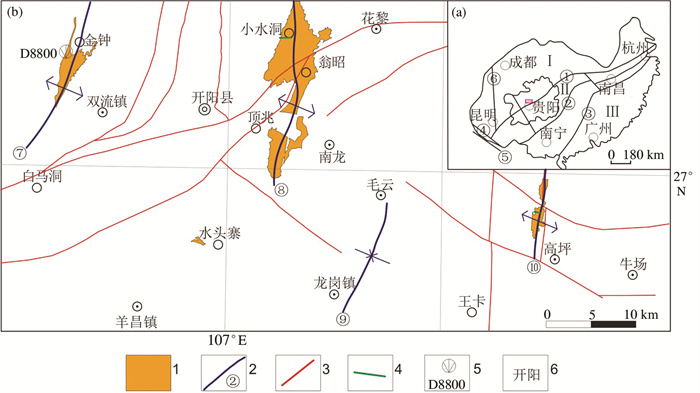
 下载:
下载:

